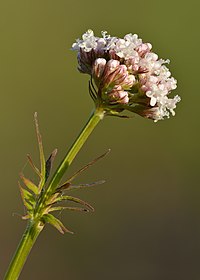
Photo from wikipedia
Common valerian (Valeriana officinalis L.) is an important medicinal plant revealing sedative, hypotensive, anti-spasmodic and anxiolytic activity. The purpose of the study was to determine the intraspecific variability of the… Click to show full abstract
Common valerian (Valeriana officinalis L.) is an important medicinal plant revealing sedative, hypotensive, anti-spasmodic and anxiolytic activity. The purpose of the study was to determine the intraspecific variability of the common valerian growing wild in Poland and the ‘Lubelski’ landrace, as to their developmental traits, chemical composition and selected genetic parameters. Both wild-growing populations (19) and the landrace (1) were evaluated under ex situ conditions. Observations of the underground organs parameters, both developmental and chemical (according to the European Pharmacopoeia) were carried out in the first year of the plant’s development, while the characteristics of the aboveground organs, followed by the sowing value of seeds (according to the International Seed Testing Association)—in the second year. The genetic analyses were performed using the NGS-DArT-seq method. Results indicate the presence of five different gene pools covering the regions of population’s origin, with a gene flow within and between them. A high level of developmental and chemical variabilities among the wild-growing populations was noticed, however without a clear relation to the region of the origin. The mass of underground organs ranged from 107.4 to 403.6 g FW × plant−1 with the content of sesquiterpenic acids at the level of 0.004–0.094%. Population no 18 was distinguished by the highest content of sesquiterpenic acids and the relatively high mass of underground organs, followed by the admixture of the gene pool, typical for the ‘Lubelski’ landrace. Unlike the ‘Lubelski’ landrace, the wild-growing populations were characterized by a high amount of an essential oils (3.90 to 10.04 mL/kg), which may be promising from the perspective of their potential use. In turn, the sowing value of the seeds obtained from the populations, expressed as the germinability, was rather low (25.25–62.25%).
Journal Title: Plants
Year Published: 2022
Link to full text (if available)
Share on Social Media: Sign Up to like & get
recommendations!